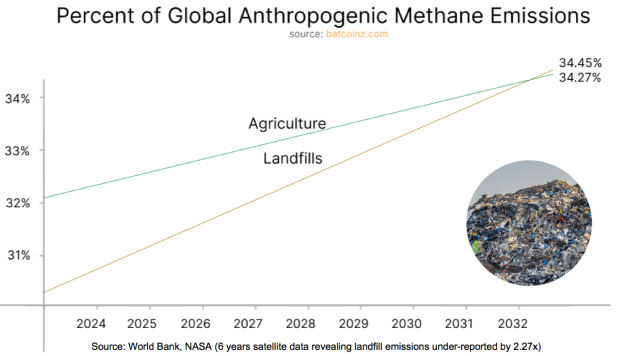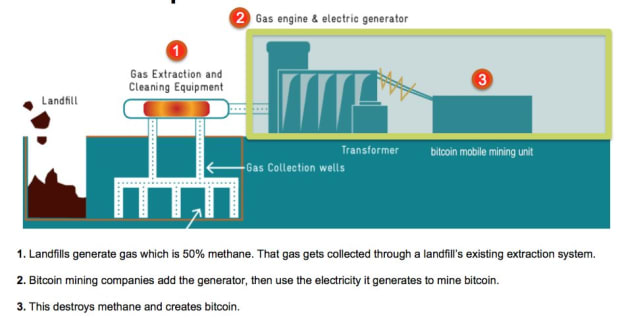Could Bitcoin Be Our Best Chance To Mitigate Runaway Methane Emissions?
[ad_1]
That is an opinion editorial by Daniel Batten, a Bitcoin ESG analyst, local weather tech investor, writer and environmental campaigner.
I didn’t get keen on Bitcoin due to its skill to resolve monetary points. My background is in investing in local weather tech. After I first heard about Bitcoin, I used to be extremely skeptical and regarded it as a unfavorable to the surroundings. Nonetheless, I used to be persuaded to place prejudice to at least one facet and consider it as I’d another know-how I used to be doing due diligence on. After evaluating the claims and information from each side I reached the conclusion that on web steadiness, Bitcoin had the distinctive skill to resolve a couple of difficult-to-solve climate-change challenge.
First, some context: I’ve been a local weather activist because the Nineties. A number of years in the past, I channeled this into working within the house of local weather tech. Between 2014 and 2019, I traveled round New Zealand, listening to among the smartest individuals within the nation discussing their concepts, and serving to them to commercialize them. Most of those concepts had been some type of local weather tech. I encountered over 200 totally different local weather tech propositions throughout this time, and arrange my first local weather tech fund on the finish of 2019.
All through that point, I by no means encountered a know-how that had the immediacy, scalability and potential influence of Bitcoin mining utilizing vented methane fuel to measurably scale back international emissions pre-2030.
Bitcoin Mining And Methane Emissions
At some point, as a part of my work on the fund, I used to be studying an article about methane emissions.
It stated that methane was 84-times extra warming than carbon dioxide over a 20-year interval, that it was rising parabolically and that the UN stated “lowering methane is our strongest lever to scale back local weather change!”
I used to be shocked. How, as a local weather tech fund supervisor, may I’ve uncared for addressing methane emissions?
I did some additional analysis and discovered that I wasn’t the one one. Out of each $1 spent on local weather tech, solely 2 cents was going towards methane mitigation, I discovered.
That day, I bought brutally sincere with myself and requested, “How a lot of a distinction am I making?” There was little doubt that we had been investing in some sensible applied sciences and other people that might scale back emissions on a world scale. However it turned out {that a} lack of emphasis on methane mitigation was not my solely oversight.
The tech we invested in:
- Was excessive danger (it’d by no means scale)
- Would solely scale back emissions post-2030
- Wasn’t addressing our most pressing emission challenge
I requested the query, “May I be doing extra?” The reply was, after all, “Sure.” I could possibly be investing in applied sciences that had been:
- Low danger
- Capable of measurably scale back emissions pre-2030
- Capable of deal with our number-one lever to scale back local weather change within the subsequent 25 years (methane)
I began researching extra about methane-mitigation know-how. Most of it was like carbon-dioxide-emission know-how: high-risk know-how that wouldn’t be out there till after 2030. Whereas there was little doubt that we also needs to be investing in these applied sciences, that was now not my focus.
I made a decision that if I had been going to create a 3rd fund, it might be optimized for quick influence, and maximize emissions lowered per greenback invested. In any other case, there was no level.
So, I started researching two issues:
- use low-risk know-how out there instantly to scale back emissions pre-2030
- What our main sources of methane had been
To reply the primary query, I checked out confirmed methods to scale back methane emissions utilizing current applied sciences. Studying the work of specialists from the Environmental Protection Fund (EDF) and in addition the USA Environmental Safety Company (EPA), there was little doubt that the know-how existed to carry out methane mitigation at scale at present: energy technology.
In different phrases, capturing that methane and sending it to a generator, turning it into electrical energy. OK, that seems like a good suggestion, notably with vitality costs spiking globally, I assumed.
So, I turned to our second query, “The place is most of our methane coming from?”
The reply, I discovered, was agriculture, oil and fuel and landfills.
Nonetheless, of these three, the one which appeared the simplest to do one thing about shortly was additionally the one which my calculations informed me can be our number-one methane emitter by 2032, overtaking agriculture: landfills.

That led me to the query that modified every part I used to be doing: “Why isn’t this being executed already?” As one professional who’d been doing landfill-based energy technology tasks since 2005 defined to me, “Landfills are by no means in the proper place. In lots of instances, negotiating with the grid proprietor is advanced and bureaucratic. And, even when you are able to do it, usually the grid wants a serious substation improve to have the ability to take that energy. It finally ends up being too costly.”
“However what if, quite than promoting that energy to the grid, you had somebody who may apply it to location, on the landfill?” I requested.
He shook his head.
“However who would wish to try this?” he requested. “Landfills are smelly locations, and the methane is a well being hazard. Nobody would wish to arrange a enterprise there.”
That was the purpose the place two worlds immediately collided for me. A number of months earlier, I’d additionally been researching Bitcoin. Not as a result of I assumed it had any deserves by way of local weather tech — the truth is, I assumed it was unhealthy for the surroundings. It was merely a pastime. I prefer to resolve points and perceive the info behind them. Bitcoin was merely in that class.
I had environmentalist mates who informed me that Bitcoin was unhealthy for the surroundings. However I additionally had a pal within the Bitcoin group who informed me that was nonsense primarily based on individuals’s lack of information of Bitcoin mining.
The turning level got here in late 2021 once I talked to Vlatko Materić, an environmentalist and the founding father of one in all our local weather tech firms who challenged my assumptions about vitality and Bitcoin, and inspired me to dig deeper. I did, and shortly discovered that he was proper: Bitcoin’s location-agnostic options and excessive proportion of working prices spent on electrical energy made it ideally suited to utilizing stranded vitality that nobody else wished or was capable of entry.

Listening to grid operators, bitcoin miners and renewable vitality engineers was vital throughout this time. Had I relied on tutorial articles and journalism, I’d have come away with some very totally different conclusions. After I did learn the latter, against this, it grew to become increasingly more obvious to me that they had been critiquing a know-how that they didn’t absolutely grasp. This lack of dependable information on Bitcoin’s environmental influence from the articles and research I learn led me to do my very own research.
Taking Local weather Motion With Bitcoin
So, skipping ahead in time, when that landfill professional stated that nobody would wish to find at landfills, I stated to myself, “I do know somebody who positively would.”
It turned out that others had already considered that, and that two Bitcoin mining firms had been both already doing landfill-gas-powered bitcoin mining, or on the cusp of doing it (Nodal Power and Vespene Energy).

After I did the maths on Bitcoin utilizing vented methane fuel, it was a eureka second. A fund that financed the deployment of infrastructure into Bitcoin mining utilizing landfill fuel may mitigate extra emissions than any monetary instrument I’d seen. It was 65-times extra emission lowering than photo voltaic installations.

To place the above chart into context, for somebody residing within the west, our calculations recommended that $108 may offset their emissions for the 12 months. Lower than $10,000 may offset their total carbon footprint for a lifetime. We did some work to construct a workforce, and provide you with a enterprise mannequin that might return a gradual yield to our wholesale buyers, and that grew to become the premise of the fund CH4 Capital.
I did not begin off as a Bitcoin advocate, however I’ve change into one. My conclusion: There’s most likely by no means been a extra vital know-how for our possibilities of mitigating runaway methane emissions, enabling the renewable transition and, as I discovered alongside the way in which, giving monetary sovereignty to greater than 4 billion individuals.
For the primary time ever, I really feel there’s one thing I can do past my very own carbon footprint that might make a distinction to our emission ranges. It is a drop within the bucket, nevertheless it’s a begin. And it is a begin that we would not have with out Bitcoin.
That’s why I say: Bitcoin is local weather motion.
This can be a visitor put up by Daniel Batten. Opinions expressed are completely their very own and don’t essentially replicate these of BTC Inc or Bitcoin Journal.
[ad_2]
Source link